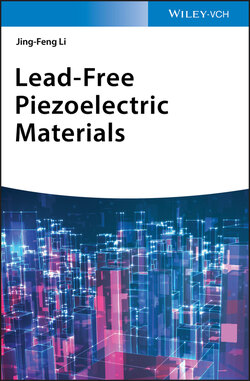Читать книгу Lead-Free Piezoelectric Materials - Jing-Feng Li - Страница 27
2.4 (Bi1/2Na1/2)TiO3
Оглавление(Bi1/2Na1/2)TiO3 (abbreviated as BNT or NBT) is another important lead‐free piezoelectric material with a perovskite structure. Discovered by Smolenskii et al. in 1961 [33], BNT had been considered as a promising lead‐free piezoelectric material system [34, 35]. BNT shows strong ferroelectric properties at room temperature, including a large remnant polarization Pr = 38 μC/cm2 and a coercive field Ec = 73 kV/cm [36]. Due to the poor sintering property of the pure BNT ceramics and the relatively low piezoelectric constant (d33 ~ 100 pC/N), many studies have thus focused on improving the piezoelectric properties through cation substitution at the A and/or B sites of BNT [36–38].
Figure 2.5 (a) Phase diagram of of (Bi1/2Na1/2)TiO3–BaTiO3 proposed by Takenaka and (b) compositional dependence of dielectric constant.
Source: Reprinted with permission from Takenaka et al. [35]. Copyright 1991, The Physical Society of Japan.
Takenaka and his research group had done extensive investigations about BNT‐based lead‐free piezoceramics. In 1991, they obtained the phase diagram of the BNT and BaTiO3 solid solution based on the combined measurement results of X‐ray diffraction patterns and dielectric and ferroelectric properties [35]. Most importantly, as shown in Figure 2.5, there exists an MPB between BNT and BaTiO3 at the composition close to 6 mol% BaTiO3. Separated by this phase boundary are the rhombohedral and tetragonal phases, similar to that in PZT. Therefore, it is also possible to enhance the piezoelectric properties of BNT‐based ceramics by utilizing the MPB effect via compositional modification. However, the BNT–BaTiO3 phase diagram has obtained several newer versions due to the incorporation of other characterization methods [39, 40]. A similar system is the solid solution between (Bi1/2Na1/2)TiO3 and (Bi1/2K1/2)TiO3 compounds, first reported by Sasaki et al. [41]. The MPB between BNT (rhombohedral) and (Bi1/2K1/2)TiO3 (tetragonal) exists in the range of 16–20 mol% (Bi1/2K1/2)TiO3 [41].
(Bi1/2Na1/2)TiO3 is an interesting system. The structural description of BNT is quite complicated, and some details of the structure are still under debate [36]. Although it is generally agreed that BNT at room temperature is rhombohedral as indicated in the phase diagram, the high‐resolution X‐ray measurements of single crystals also revealed the hints of a monoclinic phase [42]. Some studies also indicate that BNT has a composite structure at nanoscale, namely, the dispersion of short‐range‐ordered orthorhombic phase domains within a long‐range‐ordered rhombohedral or monoclinic phase matrix. The complexity may stem from the fact that there exist two kinds of ions with different valances at the A‐site of the perovskite structure. In addition, unmodified NBT and BNT‐rich BNT–BaTiO3 ceramics often show relaxor ferroelectric features, although the early phase diagram proposed by Takenaka et al. indicated an antiferroelectric region above a certain temperature as shown in Figure 2.5.
Compared with other lead‐free piezoelectric systems, the BNT system exhibits an exceptionally high electric‐field‐induced strain, which makes it particularly attractive for applications in piezoelectric actuators such as camera focusing, printing nozzle, and impact driving. It has been reported that the poling strain of BNT–BaTiO3 ceramics could reach a high value range of 0.3–0.7% by composition modification [43, 44]. However, one of the drawback of BNT‐based ceramics is the existence of a depolarization temperature (approximately 150 °C) below the Curie point, which poses a limit on the application temperature, and its underlying mechanism is still not completely understood.
